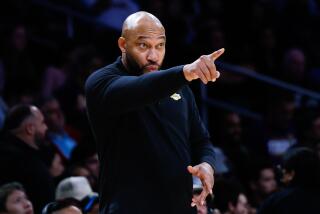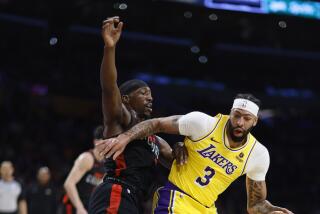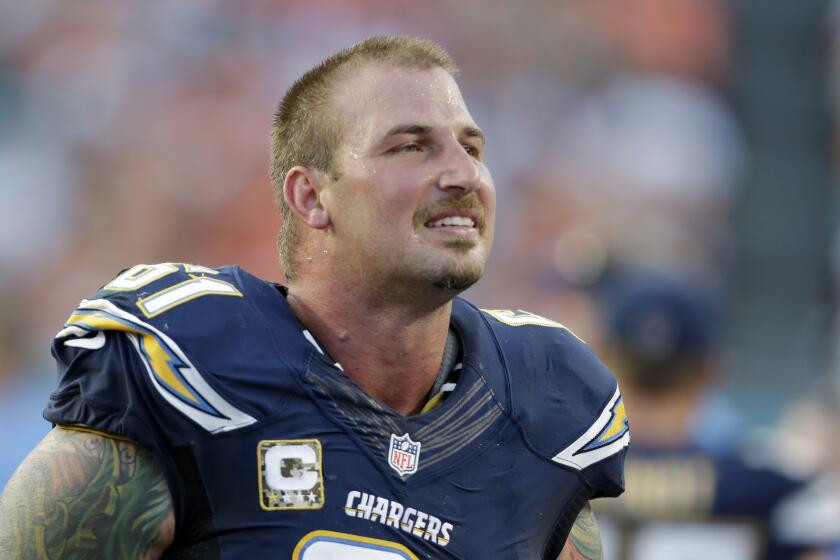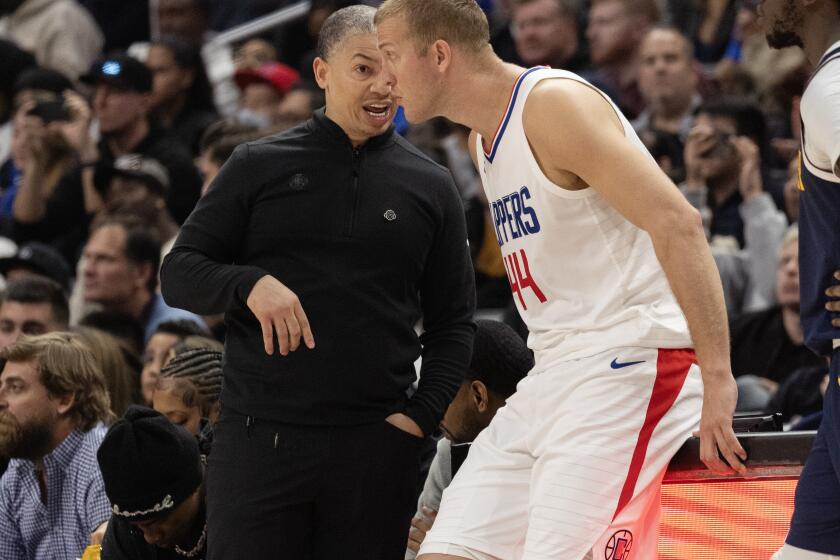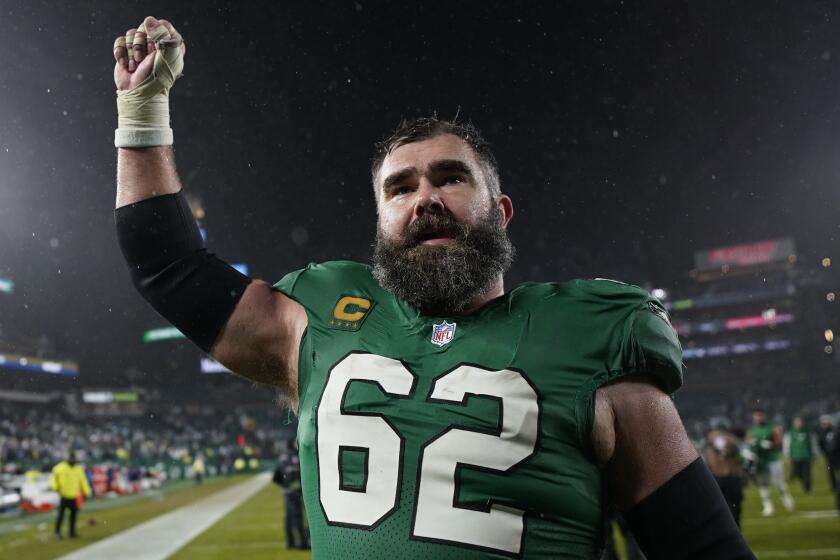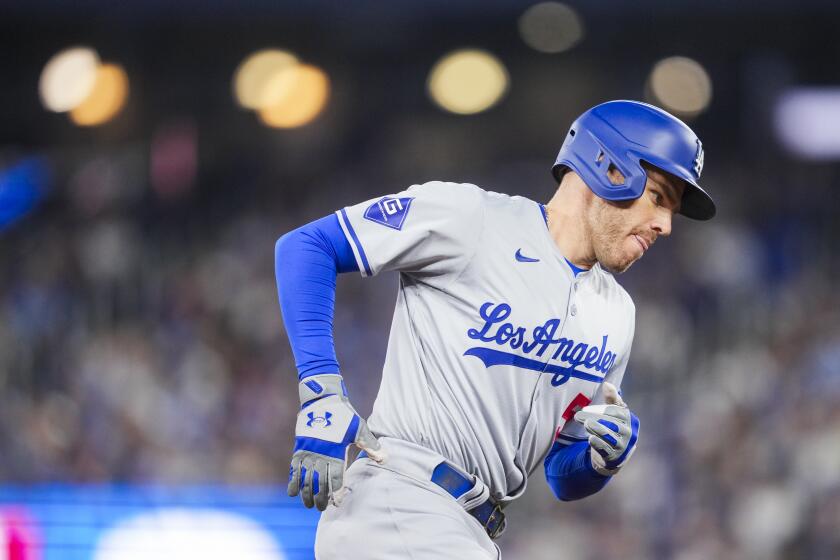DeAndre Jordan is a nice guy who might not last
Here’s one for you: What would you do?
I’ve grown to like the Clippers, love what Chris Paul has brought to them and appreciate what Blake Griffin has to offer.
It’s a fun group, Randy Foye and Caron Butler solid as individuals and Eric Bledsoe and Nick Young out of control but always in the cause of making something happen.
Mo Williams is sour, but there’s always one, or two, if you want to count Kenyon Martin.
But who needs them if DeAndre Jordan is in the room? He’s funny, easygoing and as friendly an athlete as Los Angeles has to offer.
Too bad he’s such a waste of space.
And so you see my problem.
How do you tell someone you like they’re such a disappointment, too soft and often undependable?
Yeah, I know I’m supposed to be the resident tough guy around here, but why do you think no one ever told Mister Rogers he looked dorky wearing that sweater?
No one wants to hurt the feelings of a genuine nice guy.
But right now Jordan is a bust. He’s averaging as many rebounds in 10 playoff games as Paul, who is almost a foot shorter and can’t jump with groin and hip injuries.
Jordan can’t shoot and his head is almost as high as the rim. He’s a horrible free-throw shooter too. San Antonio Coach Gregg Popovich ordered his team to foul him and the game spun in the Spurs’ direction, 96-86, as a result.
Jordan has made six free throws in the playoffs; he has had 20 tries to do so.
It’s not his fault he’s being paid $42 million over four years to be one of the Clippers’ prominent players, but how about playing like someone worried they might take his money away?
“I disagree I’m not developing; I’m physical,” Jordan says. “Do you want me to flagrant-two somebody?”
How about just grabbing the ball when it’s loose, or maybe making contact while going for a rebound rather than just trying to leap over someone?
“So that means I’m not physical?” Jordan says. “I disagree with you.”
How about some offensive moves around the basket? To date, Jordan has made two baskets in his NBA career outside the free-throw lane.
“I don’t get those shots in a game, so I can’t prove to anyone I’ve developed that,” he says.
How about not approaching every free throw as if it’s a life-or-death proposition, because if that were the case…
Or how about acting as if you’ve been to the free-throw line before?
“Every year I’ve improved,” says Jordan, a career 44% free-throw shooter who hit 52% this season.
He says he does all sorts of things that do not appear on the stats sheet, such as altering the shots of opponents.
“In the first quarter I feel like I altered about 12 shots,” he says. And whether that’s precisely true or not, the Clippers ran out to a 33-11 lead, proving what a force he can be when fully engaged.
But too often he goes missing. He played another nine minutes or so over the final three quarters, took one shot and had no rebounds.
Much of his time is spent stewing over why he’s not in the game. But sometimes when he gets in, it’s as if he’s not there. He went one whole playoff game without getting a rebound. He went another not scoring a basket because he never attempted a shot.
“It’s a rhythm thing; if you play well, you play,” he says, and excuses, excuses. “Me coming out of the game, I don’t control that.”
But he does, of course. He played the entire first quarter in Game 1 against San Antonio because he dominated, and not surprisingly the Clippers and Spurs finished tied.
He never made it back on the court in the second quarter, and maybe Coach Vinny Del Negro forgot he was there because old habits are hard to break. Too often Jordan’s play has been forgettable.
“My role is to do certain things,” Jordan says. “If people want me to go out and score 20 points, talk to my coach about that. The offense isn’t run through me. It’s run through Chris and Blake. If I get a lob or tip-in, that’s a bonus for us, I guess.
“I work on my offense and moves, but if I don’t use them in the game people just read the situation that way.”
Jordan works on his offense before every game with Marc Iavaroni, and he’s often more physical than the 55-year-old assistant coach. But once the game starts, he becomes the athlete with the pogo stick legs and the long arms reaching for the ball rather than going hard for it.
“I disagree,” he says, and if only he was more disagreeable when he took the court.
He’s nowhere near as good as he should be earning that kind of money and with the chance to start at center and play with the caliber of teammates the Clippers have assembled.
It’s so discouraging because he has shown on occasion the difference he could make inside.
He took on Tim Duncan early in the first quarter, for example, got stuffed on his initial offensive move, but stayed with it and went up again to score. Where did that come from?
He should watch that aggressive play over and over this off-season. At age 23 he has plenty of time to develop, the Clippers’ future in many ways tied to it.
“I don’t have to apologize to anybody about anything,” Jordan says. “I feel like I’m getting better.”
And I disagree.
More to Read
Get our high school sports newsletter
Prep Rally is devoted to the SoCal high school sports experience, bringing you scores, stories and a behind-the-scenes look at what makes prep sports so popular.
You may occasionally receive promotional content from the Los Angeles Times.
